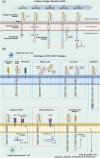CD70: An emerging target for integrated cancer diagnosis and therapy
- PMID: 40629902
- PMCID: PMC12238729
- DOI: 10.1002/ctm2.70400
CD70: An emerging target for integrated cancer diagnosis and therapy
Abstract
CD70, which is a ligand belonging to tumour necrosis factors, exhibits aberrant overexpression among multiple hematologic and solid malignancies and has drawn extensive research enthusiasm as a target to treat and diagnose cancers. CD70-targeted immuno-PET/CT is an emerging approach for cancer diagnosis, with the potential to improve tumour detection, assist disease staging, and monitor therapeutic response. CD70-targeted therapeutic approaches, involving antibody-drug conjugates, CAR-T, CAR-NK, and monoclonal antibodies, have shown encouraging activity in preclinical models and preliminary signals of efficacy in early clinical studies. In addition to these monotherapies, increasing efforts have focused on rational combination strategies that aim to enhance antitumor efficacy, reverse immune suppression, and overcome resistance. This review comprehensively summarizes the diagnostic and therapeutic advances in CD70-targeted strategies, discusses ongoing barriers, and outlines future directions to advance CD70-targeted imaging and therapeutic strategies through mechanistic research and clinical translation. Key points CD70 is aberrantly overexpressed in diverse malignancies with limited normal tissue expression. CD70-targeted immuno-PET/CT improves tumour detection, staging, and treatment monitoring. Multiple CD70-targeted therapies, including CAR-T and CAR-NK, are under active investigation. Rational combination strategies are emerging to enhance antitumor efficacy.
Keywords: CAR‐T; CD70; combination therapy; immuno‐PET/CT; targeted therapy.
© 2025 The Author(s). Clinical and Translational Medicine published by John Wiley & Sons Australia, Ltd on behalf of Shanghai Institute of Clinical Bioinformatics.
Conflict of interest statement
The authors declare no conflicts of interest.
Figures




Similar articles
-
ADI-270: an armored allogeneic gamma delta T cell therapy designed to target CD70-expressing solid and hematologic malignancies.J Immunother Cancer. 2025 Jul 1;13(7):e011704. doi: 10.1136/jitc-2025-011704. J Immunother Cancer. 2025. PMID: 40592738 Free PMC article.
-
The CD70-CD27 Axis in Cancer Immunotherapy: Predictive Biomarker and Therapeutic Target.Clin Cancer Res. 2025 Jul 15;31(14):2872-2881. doi: 10.1158/1078-0432.CCR-24-2668. Clin Cancer Res. 2025. PMID: 40388162 Review.
-
Development and Preclinical Evaluation of [64Cu]Cu-NOTA-ABDB6: A CD70 and Albumin Dual-Binding Tracer with Improved Pharmacokinetics.J Nucl Med. 2025 Apr 1;66(4):552-558. doi: 10.2967/jnumed.124.268835. J Nucl Med. 2025. PMID: 40015924
-
CD70 CAR T cells secreting an anti-CD33/anti-CD3 dual-targeting antibody overcome antigen heterogeneity in AML.Blood. 2025 Feb 13;145(7):720-731. doi: 10.1182/blood.2023023210. Blood. 2025. PMID: 39571145
-
CD70-targeted cancer theranostics: Progress and challenges.Med. 2025 Aug 8;6(8):100671. doi: 10.1016/j.medj.2025.100671. Epub 2025 Apr 17. Med. 2025. PMID: 40250430 Review.
References
-
- Bray F, Laversanne M, Sung H, et al. Global cancer statistics 2022: GLOBOCAN estimates of incidence and mortality worldwide for 36 cancers in 185 countries. CA Cancer J Clin. 2024;74:229‐263. - PubMed
-
- Krishna S, Murray C, McInnes M, et al. CT imaging of solid renal masses: pitfalls and solutions. Clin Radiol. 2017;72:708‐721. - PubMed
-
- Kim JH, Sun HY, Hwang J, et al. Diagnostic accuracy of contrast‐enhanced computed tomography and contrast‐enhanced magnetic resonance imaging of small renal masses in real practice: sensitivity and specificity according to subjective radiologic interpretation. World J Surg Oncol. 2016;14:260. - PMC - PubMed
Publication types
MeSH terms
Substances
Grants and funding
LinkOut - more resources
Full Text Sources
Medical
Research Materials
